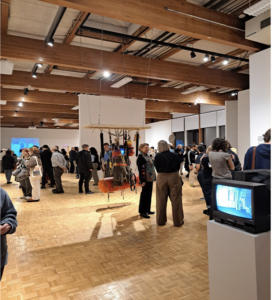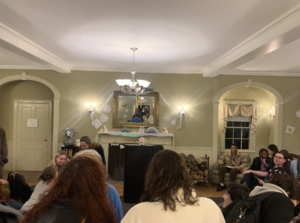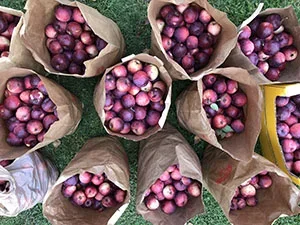In Union Springs, New York, there is a gas station sitting along Route 90, a stretch of highway that runs adjacent to Cayuga Lake. As the primary artery connecting the various towns spotting this section of Upstate New York’s Finger Lake’s region, Route 90 is either always occupied one way or another, in various extremes in traffic—from chronically busy during the summer, featuring towering boats and trucks bulging with fishing equipment—or not at all, where the empty dystopian silence of a road have been touched perhaps only twice in the last 12 hours.
Approximately every twenty minutes, you pass a road sign bearing a cheery greeting, a flash of warm-welcomes capturing the idealistic camaraderie of the town; they are nearly identical to Union Springs, to the point where most have at least one gas station. Union Springs is different in that—given its size and lack of notoriety—the gas station shifts from a typical necessity to cultural landmark. In the after-school hours between classes and sports, those idyll moments where adolescents are left to their own devices and ambitions, students visit the gas station for energy drinks and junk food, necessary fuel for the tired scholar often trapped at school until as late as nine p.m. (athletes, musicians, performers, etc. were left to push their extracurriculars into the evening). The entire town relied on that gas station as well, with the alternative being a 20-30 minute trek into the nearby city branching off of Route 90, or to one of the other towns spotting the highway. Bodies passed in and out like clockwork, filling their tanks, buying food or drinks, chatting with the occasional loiter, or buying cigarettes; the first thing those bodies noticed, however, was a stack of road signs and flags, all of which possessed the haunting echoes of Trumpian rhetoric; besides the usual “Make America Great Again” and “Trump 2020,” there were overtly racist and violent messages. One sign, hung at eye level just above a precarious stack of other signs next to an aisle riddled with candies, soda, chips, and snacks, with the image of a man pointing a shotgun at the viewer, a sign read “If You Open Your Mouth, I’d Better Hear English.”
Since 2016, rhetoric like this has become all too common, so much so that it is solidified in the omnipresent barrier of the South Border Wall, a symbol of the former Trump Administration’s nationalistic attempt to cling to power, playing off of the nationalistic illusion that the wall will preserve American society. In reality, according to Wendy Brown, the wall is simply an illusion, a “spectacularized power” boasting “symbolic effects in excess of their obdurately material ones” (Brown 51). In other words, the functionality of the wall is non-existent and serves only to define or defend “political identities [that] have shaped collective and individual identity within as they aimed to block penetration from without” (52). The wall serves no purpose but to behave as a physical landmark of a xenophobic sentiment that serves the nationalism that the United States relies on to validate its power; thus, racist slogans, messages, signs, rhetoric, etc. proliferate the nation’s narrative in order to serve the idea of an “us and them” or “friend-enemy” relationship. Messages of hate follow; if the wall is composed as a means of perpetuating American nationalism, a symbol of geographic division, then what follows is xenophobia, since the wall’s narrative needs an “enemy” to validate its existence. With this, the sign becomes just one of the many vessels on which is written this nationalistic sentiment; it idealizes America just as the South Border Wall does, in that it separates the country into a nation-wide gated community, putting forward the narrative of American dominance. The message behind the rhetoric demanding immigrants to “Speak English” touches a deeper focus, as it becomes itself a “wall,” purposefully heightening English to the stance of a superior colonial language; in other words, immigrants entering America are expected to either homogenize and silence their mother tongue or suffer the villainization that comes from lingual differences.
On a cultural level, this political and nationalistic division behaves as reinforcement of “white innocence,” a concept Cathy Park Hong criticizes deeply in her book Minor Feelings. Childhood is often aligned with notions of innocence, an idea that was largely popularized by William Wordsworth in the 19th Century, a means of preserving the adult perspective’s nostalgic “uncorrupted” memory of the past.
The trend continued throughout pop-culture; Hong appropriately scoffs at the absurdity of Catcher in the Rye, as the protagonist flaunts his privilege in pursuit of a childhood idyll that he wishes not to move away from. Hong said it the best when she defined the protagonist Holden Caulfield as an “entitled asshole” mourning the loss of his childhood innocence, a notion built on the concept of whiteness. In America, people of color are forced to grow up earlier as they are treated as adults under the white gaze; Hong recounts her rage at seeing Wes Anderson’s Moonrise Kingdom as inadvertent preservation of white paradise (“It’s as if the Neverland of New Penzance is the last imperiled island before the incoming storm of minorities floods in,” she writes,) and the racism she experiences as a kid that forced her to realize that, in the eyes of White America, her humanity is invisible (Hong 68-73). America is thus caught in a narrative of “white innocence;” rather than face the privilege associated with whiteness on a systemic level, white people feel threatened by the shame this exhumation inflicts upon them as they are confronted with that same privilege. When made aware of “the capitalist accumulation of white supremacy” that has enriched white privilege, the innocent narrative surrounding whiteness is challenged, and in order to preserve that power, messages like “All Lives Matter” and xenophobic phrases that demand immigrants to “Speak English” are perpetuated to—like the border wall—shelter white people from the truth of their society: that it is built on systemically racist structures, and whiteness as a construct must be confronted to generate equity.
This “white innocence” enters the sphere of language, as English is used as a mark of superiority; it is used as a colonial language today, in this xenophobic rhetoric, as a means of allowing white innocence to go untouched, maintaining the social structures that keep this privilege (and the implied power and supremacy associated with said structures) intact. This idea is something that behaves along a linguistic level, as the English language is used as an agent of white supremacy through this particular lens. With this in mind, language itself can be used as a force of resistance to subvert the colonial usages of English in America; if racist white people use English as a force of hegemony, then it can be resisted if that language is reclaimed by the oppressed. In other words, the history behind English colonialism, one that instills and reinforces this “white innocence,” can be combatted through the use of English by the marginalized communities who were oppressed under that same colonialism; one course of action to engage in this subversion, in this decolonization of America on a systemic level, is through literary translation.
Lina Mounzer’s essay “War in Translation” details her personal experiences as an immigrant suffering the trauma associated with the war she bore witness to. She opens her paper with a haunting catalog of carnage; she had been forced to move “no less than 35 times,” she buried “seven husbands, three fiancees, fifteen sons, and a two-week-old daughter,” and watched the cities she called home “burn” from the wreckage inflicted upon by military bombing among countless other events. At the time of writing the essay, she was in Beirut, translating dispatches from migrant women who, like her, fled conflict to survive. In doing so, she bore witness to the mass of trauma they suffer:
I have witnessed them march in the streets calling for change, bury loved ones, resuscitate strangers, defy soldiers and snipers, wait in breadlines, pack their whole lives into vans and cars, undergo daily humiliation at checkpoints on their way to and from work, to and from university, which they have refused to leave or discontinue.
The word “witness,” in and of itself, for Mounzer is too soft, too delicate, to capture the strength she feels in translating the writings of these women. Translating transcends physical “seeing” as her own body slides into their words; “the translator’s body,” she writes, “is the vessel of transfer. The mind equates words, expressions, deals with techniques and logistics…it is within the body that the real alchemy—mysterious, unnamed, and inexplicable—takes place.” This bodily experience renders the translator and the language in which they are traversing through subject to the pain that language captures; “Neither the translator nor the text emerges from the act unscathed.” As such, her own voice enters the first person as she translates, and the “I” of the writer becomes her own until they transplant her own feeling—on a collective, empathetic level—into the text itself. She translates from Arab to English, the latter being her second language, something she had to learn as a result of her own migration (this bodily translation is especially important to Mounzer, as her own personal narrative overlaps with those of whom she translates,) something that took years of development; “It has taken me a long time,” she writes, “to use it as I wish, to break [English] and retake it.” Her translation thus embodies the cross over between “that which is felt, experienced, to that which is voiced,” an interconnection “Between the self and other, between where you come from and where you end up, between the personal narrative and collective history, between genders and cultures and languages and countries and the similar calls for dignity and recognition contained in stories. The only way to make borders meaningless is to keep insisting on crossing them” (Mounzer 134-151).
Mounzer points out an inherent connection between language, culture, and identity; translation becomes an act that holds within the words themselves the sheer weight of those who speak it. Just as she is transported, on a bodily level, into the narratives of the women she translates, language itself behaves in a similar way, slipping as the constituents of that dialect do, between the various spaces in which they exist. Lydia Duff, a student at Bennington College, verbalizes the abstraction behind this “slipping” as “self-creation, self-mythologizing” as the linkage between language and culture behaves as a “window” through which the deeper complexities of languages behave. Another student named Emmanuel Barrera uses translation—although not in a literary sense—to survey the experiences of multiple cultural groups, a means of slipping between this linkage in order to remove the taboo surrounding mental health issues that penetrates families across cultures; he too passes through a window allowing him to remove the idyllic narrative surrounding this taboo that silences mental health issues (as taboos are often masks behind which lurk systemic issues.)
It is through this window that Mouzner’s transportations occur; as language holds the weight of experience, people hold that same language as a result. The weight of what is said, what is experienced, must likewise traverse through this space, riding along the body in the form of a continuous “crossing-over.” Just as words construct a sentence, the meaning behind those words, on a linguistic level, construct a narrative on an individualistic level. The “I’s,” in this process of “self-creation,” carry the kinetic speed through which the social barriers Mouzner describes are shattered. In other words, as Mouzner translates language, she also translates the meaning behind the vocabulary, carrying experience, meaning, culture, identity, and history. So, as she translates into English, she breaks it; in using it as a vessel for sharing the narratives of those who have suffered under systemic violence, she reclaims English from its colonial harborers. Translation becomes a literal force that breaks barriers surrounding social institutions; the fabric on which oppression is built is rendered useless as language itself crosses structural inequity to give visibility to the truth, that same narrative that threatens “white innocence,” and the racist rhetoric surrounding the demand to “Speak English.”
Translation is a force that systematically exhumes marginalized forces in solidarity against the sentiment that constructions like the South Border Wall exacerbate., including nationalism, white innocence, white fragility, and the overarching institution of whiteness as a whole. With the “crossing over” of barriers that translation provides, language is able to carry a socio-cultural identity of its own that is empowered by the voices being translated; although Mouzner’s essay is not centered on American systems, her theory can be applied to it, and in doing so, the white imaginary and innocence on which systemic racism and oppression are held aloft are able to be broken down, as the colonial implications of English are reclaimed for the sake of liberating marginalized voices. In doing so, the nationalistic, illusionary idyll of white America is challenged, shattering the sentiment symbolized by the border wall and racist rhetoric, and generates the change for the promotion of a liberated identity and cultural individualism.
Sources:
Brown, Wendy. Walled States, Waning Sovereignty. Zone Books, 2010
Hong, Cathy Park. Minor Feelings. One World, 2020.
Mounzer, Lina. “War in Translation,” Kitchen Table Translation by Aster(ix) Journal. Blue Sketch Press, 2017.

Dylan Walawender is a first-year student studying literature and creative writing, with a little bit of philosophy and psychology worked in there. He enjoys reading, writing, and nature stuff like hiking, finding plants, things of that alignment.










Be First to Comment